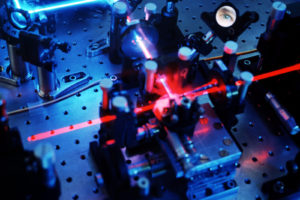Quantum encryption is now fast enough for voice calls

Quantum cryptography. Eye of an observer reflected in a mirror in quantum cryptography apparatus. Quantum cryptography is based on the principle of entanglement, a property of a pair of particles in which a change to one has an instantaneous effect on the other, no matter how far apart they are. Cryptography in this case refers to the encoding of data so that only specified targets can access it. If the sender and the receiver of the data share entanglement then any data is only readable by them alone. This is more secure than existing encryption methods, most of which rely on mathematical algorithms. Photographed at the lab of Anton Zeilinger at Vienna University, Austria.
...researchers have developed a quantum encryption key distribution system that promises to be five to 10 times faster than existing methods, or roughly on par with conventional encryption when run in parallel. The trick was to cram more data into each photon.
Normally, you can only encode one bit per photon by using a weak laser. The team discovered that it could encode two bits by tweaking the release time of photons and using high-speed photon detectors to track these changes. Effectively, they're giving photons properties they couldn't have before.
There's a lot of effort left before this becomes practical, not the least of which is the size: a transmitter/receiver combo would be about as large as a computer. It's more realistic than you might think, mind you. All the parts beyond the single-photon detector are readily available, and it could even be used for "free space" (read: over the air) transmissions. Eventually, there may be a time when you could hold a secure voice chat knowing that even the most determined spy couldn't listen in.
See the full story here: https://www.engadget.com/2017/11/26/scientists-develop-fast-quantum-encryption/
Pages
- About Philip Lelyveld
- Mark and Addie Lelyveld Biographies
- Presentations and articles
- Tufts Alumni Bio